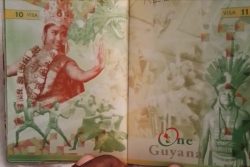These are challenging times for the jewellery industry. Fast rising food prices and the more general rise in the cost of living have reduced the levels of disposable income among ordinary Guyanese, impacting on their ability to indulge in the time-worn pursuit of buying jewellery; but the Maraj brothers say that it will take more than tough times to cause them to loose faith in the jewelry industry. They continue to run their famed family business on the principle that tough people outlast tough times.
 L. Seepersaud Maraj & Sons was inherited by the three brothers from their father who, 72 years ago, started the family’s rise from his own toil on the Diamond Sugar Estate to engrave the family name indelibly in the annals of the local jewellery industry.
L. Seepersaud Maraj & Sons was inherited by the three brothers from their father who, 72 years ago, started the family’s rise from his own toil on the Diamond Sugar Estate to engrave the family name indelibly in the annals of the local jewellery industry.
Sharma Maraj is the second of three brothers who have kept the family business alive; and while he is mindful of the fact that the price of gold has more than doubled over the past two years and that less disposable income has meant less purchases, he appears driven by the view that history is everything.
Sharma refuses to dwell on the theme tough times. He wants, instead, to talk mostly about what he says are “the principle and integrity” that his father stood for, virtues which, he insists, have remained part of the L. Seepersaud Maraj tradition; and he wants to talk about the various ways in which what is the oldest family business in the Stabroek Market has been honoured by the Georgetown City Council and about the fact that the brothers have enjoyed the distinction of being jewellers to royalty – to the Duke and Dutchess of Kent during their visit here in 1966 for Guyana’s independence celebrations.
Rather than respond to questions on how business is doing these days he prefers to reflect on just how far L. Seepersaud has come, from the days when an intrepid Indian estate worker and his wife travelled across coastal Guyana courting customers with samples of jewellery to the thriving business that exists today.
 And perhaps the greatest mystery of all is the fact that one of Guyana’s oldest, best-known and most successful jewellery businesses has chosen to remain anchored to its roots inside what some might say is the “seedy” environment of Stabroek Market, the haunt of characters whose appearance do not always fill you with a sense of trust.
And perhaps the greatest mystery of all is the fact that one of Guyana’s oldest, best-known and most successful jewellery businesses has chosen to remain anchored to its roots inside what some might say is the “seedy” environment of Stabroek Market, the haunt of characters whose appearance do not always fill you with a sense of trust.
For the Maraj brothers it’s really a matter of being comfortable in an environment with which they are familiar. Sharma remembers “growing up in the market,” playing in the isles of the old structure before finally falling asleep beneath the pillars of the edifice. And while, he says, the issue of eventually relocating is not exactly off the agenda, the ties that bind them to the spot where the business was born all those years ago are still as strong as ever.
Remarkably, all three brothers have worked full-time to preserve their father’s legacy. They have remained together, raising their separate families but never breaking the bond left them by the business that their father started.
Heera, the eldest, is an austere gentleman, who, during this interview, was prepared to defer to Sharma, interrupting only to make important interventions on issues that predated his younger brother’s adult memory. The youngest brother, Ram appeared to have drawn the lot of minding the store – so to speak – during the interview.
And even as they have worked to keep the business going the two younger brothers have taken time out to pay attention to academic pursuits that have added value to their understanding of commerce. Both are graduates of the University of Guyana in Business and Economics.
Sharma makes the point that the price of gold having doubled over the past two years, L, Seepersaud & Sons has had to face new challenges. He insists that what has sustained the business in difficult times is its reputation, “its tradition for a quality of service” that has kept its customers loyal.
Sharma says that the current challenges facing the local jewellery business began to emerge about three years ago. Gold prices apart, he cites the fact that the vast majority of what he describes as “ordinary customers” have had to face the problem of reduced disposable income. “We have had to face that fact that food and other essential items come higher on their scale of priorities than buying jewellery.”
Sharma insists however that not even the prevailing economic crisis has sated the Guyanese appetite for gold. Guyanese, he says, have a cultural affinity” for jewellery. “Guyanese have a tradition of buying jewellery. From the time a child is born they want to give a little gold gift. Then there are christenings, engagements, weddings and various other milestones in people’s lives, most of which are celebrated with gifts of jewellery; and although these little things cost more these days, ordinary people still hold fast to the tradition.”
What has sustained L. Seepersaud Maraj and Sons us a clientele that has been built over the years and which comprises mostly overseas customers. Sharma says that the firm has been dealing with overseas-based Guyanese clients for decades. “We know some of them even before they left Guyana and whenever they return they come back to us for new jewellery or to have things done over. That aspect of the jewellery business is important because overseas-based Guyanese tend to have more disposable income.
Then there is what Sharma describes as “the reputation of Guyana’s jewellery” that attracts customers from the region and beyond. Advertisements by L. Seepersaud Maraj and Sons can be seen in in-flight magazines, regional magazines and newspapers and print media with a circulation that extends to North America and Europe.
Sharma says that “the better clients” tend to come from the United States and Canada, But he says, with the United States facing a recession customers who come to Guyana spend less on jewellery.
Inevitably, he returns to the theme to ‘the captive market,’ those ordinary Guyanese with ‘the gold habit.” Sharma says that L. Seepersaud Maraj’s awareness of “where we are located” in the jewellery industry is a critical factor in shaping its marketing strategy. “Because the purchase of a piece of jewellery is a pretty important thing for an ordinary customer we have to be prepared to give personalized service.
People look for the best that they can get for their money and we have to develop an approach that responds to that reality. We have to spend time with them, going through the various changes of mind and the bargaining. What we seek to do is to ensure that they are comfortable with what they get for their money.”
Sharma insists that trustworthiness and integrity are not just marketing buzzwords in the jewellery business. “When people buy jewellery it is actually a genuine investment of trust in the seller. They look for value; they look for jewellery that they can trust. If you disappoint a customer in a matter as important as buying jewellery the consequences for you business can be disastrous. Ask yourself why L. Seepersaud Maraj & Sons has survived in an environment where we have dealt with thousands of very ordinary customers over the years?
With CARIFESTA X on the horizon L. Seepersaud Maraj & Sons is already busying itself with new designs and new patterns that target the regional market. Sharma recalls that last year’s Cricket World Cup brought an influx of new customers and he is optimistic that CARIFESTA X will bring a fresh wave of lovers of Guyana gold. “For us it is much more than attracting one-off customers. What we are hoping is that what we offer to visitors for CARIFESTA will convert more people to Guyana gold. While we are in business we also believe that what we do also serves to promote what is good about Guyana,“ Sharma says.









